The first barbell curl was probably performed about three minutes after the barbell was invented and it’s been a gym staple ever since. This timeless exercise has always been reliable and effective for building a set of bulging biceps. It might be seen as a very simple movement — grab the bar, curl the bar, … Read more
The post How to Do the Barbell Curl for Bigger Biceps appeared first on Breaking Muscle.
The first barbell curl was probably performed about three minutes after the barbell was invented and it’s been a gym staple ever since. This timeless exercise has always been reliable and effective for building a set of bulging biceps.

It might be seen as a very simple movement — grab the bar, curl the bar, done — but like many straightforward exercises, details can have a big impact on your results. While there is a wide range of curls at your disposal, let’s break down why this biceps-building exercise should remain at the top of the list.
- How to Do the Barbell Curl
- Barbell Curl Mistakes to Avoid
- Benefits of the Barbell Curl
- Muscles Worked by the Barbell Curl
- Who Should Do the Barbell Curl
- How to Program the Barbell Curl
- Barbell Curl Variations
- Barbell Curl Alternatives
- Frequently Asked Questions
How to Do the Barbell Curl
Visually, the barbell curl seems like a pretty straightforward exercise. You’re just bending your arms.
The truth is, there is a little more happening behind the scenes that can take you from having decent biceps to a having a great-looking set of arms.
Step 1 — Stand Tall and Proud
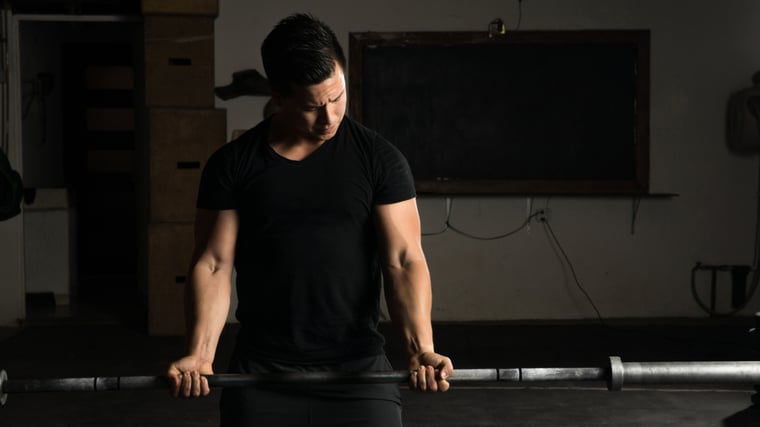
Stand holding a straight barbell with your hands slightly wider than hip-width and palms up. Your arms should be fully extended. Retract your shoulder blades and think about keeping your chest high and proud.
Take a breath and engage your core. Contract your triceps to make sure your biceps are fully lengthened. This assists in recruiting all the muscle fibers and ensures a full range of motion. Fix your elbows near your ribs. Your biceps should be slightly touching the outside of your chest.
Form Tip: If you have average or shorter arms, the standard hand width will be effective. If you have relatively longer arms, you can benefit from gripping the bar much wider than hip-width. Gripping too closely can put your arms into a significant internal rotation at the shoulder, which can increase joint strain.
Step 2 — Curl the Weight
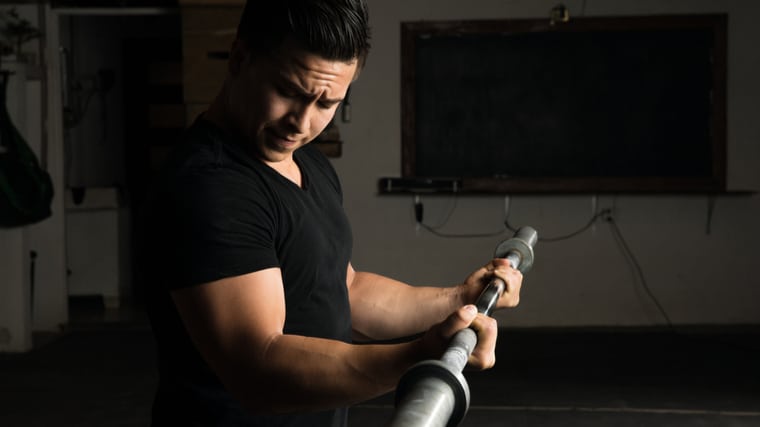
Contract your biceps while breathing out. Keep your shoulders in place and continue curling until your biceps are fully shortened.
As you reach the top of the movement, curl your wrists towards your body and grip the barbell tightly. This helps to fully contract your biceps while also strengthening your forearms, wrists, and grip.
In the top position, your elbows should finish a little further in front of the body. This is okay since it is further activating the biceps (specifically the long head of the muscle). (1) Just make sure to not let your shoulders come too much into play and take over as a primary mover.
Form Tip: Throughout the exercise, keep the inside of your biceps gently in contact with the outside of your chest or serratus. This is a great way to make sure you are in the correct position for maximum your biceps recruitment, and prevents your elbows from moving too far forward or back.
Step 3 — Return to the Start
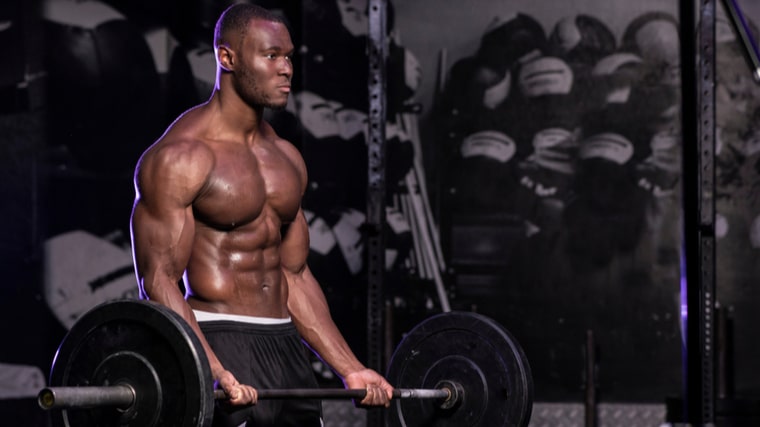
Take a short breath in before you lower the weight under control. Again, be mindful of where the inside of your biceps are touching (chest and serratus). Keep your shoulders pulled back.
It is important to lower the barbell under control. Aim for a two to three second eccentric, which will recruit even more muscle fibers which can provide you with a greater opportunity at building more muscle.
Form Tip: After each rep, take a full inventory. Are your shoulders rolled forward? Have your elbows moved back behind your body? You should be finishing the rep exactly how you started — with the inside of your biceps slightly outside your chest or serratus, your elbows in front of your body, and your shoulder blades retracted with your chest high and proud. Don’t begin your next rep until you’re in the right position.
Barbell Curl Mistakes to Avoid
Like many exercises, the barbell curl is simple and effective when executed correctly. When executed correctly being the most important words. Let’s look at some of the common errors that can occur if you are not paying attention to technique.
Too Much Upper Body Movement
Swinging your torso front and back as you curl a barbell up and down is the quickest way to not see results and possibly find an injury. Not only does it decrease muscular tension on the biceps, but swinging weights is a clear indication that you’re trying to move weights that are way too heavy to lift with strict form.
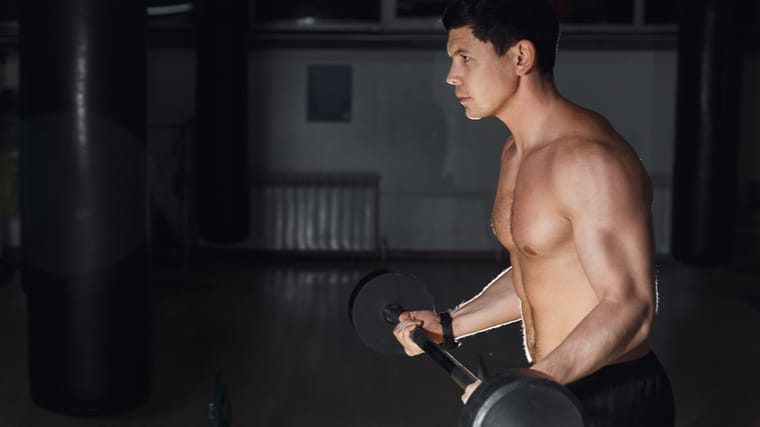
Heaving the weights with your entire upper body instead of focusing the work on your biceps also increases your chances of straining your lower back. That’s the type of potentially chronic injury which can impact your entire training plan for the long-term.
The only exception to this is when you deliberately use your entire body to move very heavy weights in order to emphasize the eccentric (lowering phase) with strict control. This is a specific exercise variation, which will be discussed in a later section. It is an intentional movement to spread force through your legs, back, and shoulders, rather than swinging your hips and putting stress entirely on your lower back.
Avoid It: Keep your shoulder blades retracted, and tense your abs and glutes during each rep to better maximize muscular strength. Control the descent for two to three seconds to decrease the urge to swing the weights and recruit your biceps much more effectively.
Gripping the Bar Too Wide
Some lifters mistakenly believe that bench pressing with an extremely wide grip will increase the width of their chest. Many lifters also make the mistake of curling with an extra-wide grip hoping it will sculpt their biceps differently. The body doesn’t work that way.
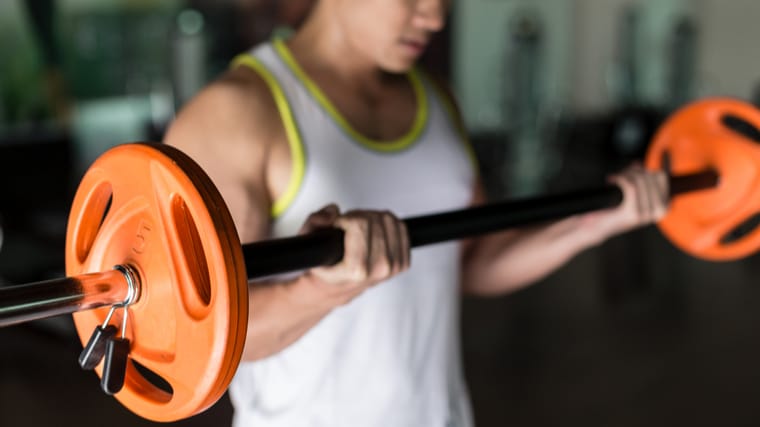
Taking an incorrect grip increases the chance of straining the forearm and biceps tendons at the elbow joint because tension isn’t being focused on the muscle itself. When stress is too much for the arm musculature to tolerate, and as you fatigue during a set, it creates wear and tear leading to the biceps tendon tears.
Avoid it: Refer to the technique setup and grip width appropriate for your limb length. If you have longer arms, you’re more likely to require a wider grip to maintain relative stress on the muscles due to leverage, well-outside your shoulders and up to double your hip-width. Otherwise, keep your hands closer to hip-width.
Benefits of the Barbell Curl
The barbell curl has long-been used to build size and strength in the biceps. Here’s a closer look at several benefits of this is foundational exercise.
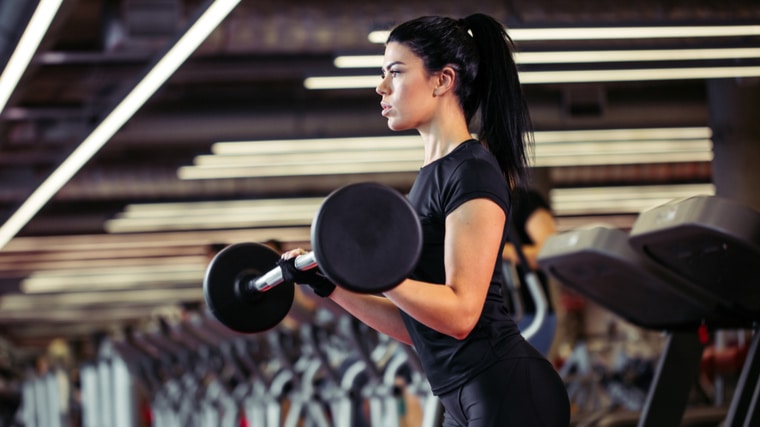
Beginner-Friendly
The barbell curl is an excellent exercise for new lifters due to its quick learning curve, basic mechanics, and ability to load the exercise with ease. It’s a highly effective fundamental lift as a simple and effective introduction to direct arm training.
Direct Biceps Training
The barbell curl is performed purely with elbow flexion, which is a major function of the biceps and no other body part. Because of this focused work, it’s one of the most effective exercises to improve size and strength in the biceps, specifically.
Potential for Heavy Weights
If you want to build strength, you need to move relatively heavy weights. The barbell curl allows you to put the biceps under the heaviest potential weights compared to other biceps exercises. This can contribute to greater overall strength, particularly with pulling exercises like deadlifts and rows.
Muscles Worked by the Barbell Curl
The barbell curl is essentially a single-joint (isolation) exercise that is one of the most effective ways to target the biceps, primarily, and the forearms as secondary movers. However, the barbell curl does incorporate a small degree of movement at the shoulder joint which also activates the anterior deltoid (front shoulder muscle) as an additional mover.

For this reason, some lifters consider it a multi-joint (compound) exercise under the most technical definition of the term, often when they exaggerate or emphasize the elbow-rising position at the top of the lift.
Biceps Brachii
The biceps are a two-headed muscle with the long head located on the outer part of the muscle and the short head on the inner side of the muscle. The long head attaches at the shoulder blade while the short head attaches at the upper arm, and both heads connect near the elbow. This is why both heads are activated when bending the elbow and the long head is recruited to move the arm at the shoulder.
Forearms
The forearms include the wrist flexors aligned with the palm-side of and the wrist extensors on the top side of the forearm. Both muscles work actively to hold and stabilize the barbell as you curl the weight.
Anterior Deltoid
The deltoid (shoulder muscle) is comprised of three separate heads — the anterior (front), lateral (side), and posterior (rear). Each head is activated to move the arm in its respective plane. During barbell curls, the anterior delts contribute to raising the arm when the barbell is in the fully curled position.
Who Should Do the Barbell Curl
Any lifter that steps foot into the gym can benefit from including barbell curls in their program. It’s a simple and versatile movement that can be programmed for several goals.
This exercise will aid in increasing muscle mass, improving arm and grip strength, and injury prevention for performance athletes that may have a higher chance of biceps or elbow injuries.
Strength Athletes
Strength athletes, including strongmen, strongmen, and powerlifters, will find that improved biceps strength carries over to increased stability during heavy pressing and pulling exercises, as well as improved grip strength. Light weight, high-rep barbell curls can also have restorative and preventative joint health benefits. (2, 3)
Physique Athletes
The barbell curl can provide any physique-focused lifter the most bang for the buck when it comes to building a more muscular set of arms. The barbell curl can accommodate much heavier weights than many other biceps exercises, which creates more programming options for more muscle-building stimuli.
How to Program the Barbell Curl
Just because the barbell curl is simple to perform, don’t think you can just walk into the gym and knock out random reps with no plan of attack. Below are some effective programming options that you can use going into your next session.
Heavy Weight, Low to Moderate Repetitions
To maximize strength, three to five sets in the four to eight rep range is a good place to start. Use a weight that allows you to leave at least two reps left “in the tank”, since curling very heavy weights to muscular failure can disrupt technique.
A rest period of two minutes and thirty seconds to three minutes after each set will ensure you are able to continue lifting with maximal effort.
Moderate Weight, Moderate Repetitions
To maximize muscle growth, aim for three to four sets in the six to 12 rep range. This will give you a bump in training volume, which is beneficial for building muscle. (4) The addition of sets and volume will allow you to develop better coordination of the movement and thus better recruitment of the biceps muscle overtime.
Barbell Curl Variations
The standard barbell curl can be worked around using specific variations, for a lifter’s individual needs such as injury history, or for general change in training.
EZ-Bar Curl
This very subtle, very effective variation can provide some relief on the wrist joints and elbow joints if maintaining a palms-up (supinated) grip on a straight barbell causes discomfort. The angled grip decreases the wrist mobility needed to maintain a full palms-up grip, which reduces strain on the wrist, forearm, and elbow tendons.
The overall execution of this exercise is identical to the straight barbell curl. The angled grip also slightly alters recruitment and incorporates more forearm musculature into the exercise.
Cable Curl(s)
Attaching a straight bar to low-pulley cable will provide constant tension throughout the entire range of motion. There are two very effective ways you can make use of this variation. The first option is to stand upright and perform the exact same technical instructions as the barbell curl, using the cable pulley.
A more intense option is to lie on the ground and perform the same curling movement. This is one of the most strict curl variations since cheating with a swinging torso is simply impossible. This can also be a great biceps finisher at the end of your workout, putting the emphasis on maximum the time under tension to fully exhaust all muscle fibers.
Eccentric Barbell Curl
This variation is all about overloading the biceps during the lowering portion of the rep. The lengthening of a muscle under load has been shown to cause a high amount of muscular stress, which leads to a higher stimulation for muscle growth. (5)
Aim for five to eight seconds to lower the barbell from the top position to fully straight arms. This specific variation is one time when it’s acceptable to use a heavier-than-normal weight and perform a cheat rep to bring the weight into the starting position. Because the biceps contraction is not a priority, use coordinated leg and back drive to lift the weight — do not simply swing with your back.
Barbell Curl Alternatives
The time-tested barbell curl can be extremely useful, but some alternatives offer specific benefits the classic barbell movement can’t match. Here are some options to consider implementing into your workout.
Standing Dumbbell Curl
The standing dumbbell curl is performed nearly identical to the barbell curl with a strict upright stance and no swinging torso.
The dumbbells’ biggest advantage is the ability to work each arm independently, which strengthens any discrepancies that often develop naturally from performing bilateral-only exercises (working both arms work as a single unit).
Barbell Preacher Curl
The preacher curl puts the muscle under more stress in the lower portion of the range of motion. This unique stimulus and intense contraction assists in triggering more muscle growth.
With the preacher bench, your arms are set at a downward angle. Your upper arms and shoulders are supported by the pad to minimize any unwanted movement and to help isolate your biceps more effectively.
Barbell Spider Curl
While this appears somewhat similar to a preacher curl with the upper arm angled from the body, the key difference is that the most difficult part of each rep is in the fully shortened position at the top of the movement, not the bottom.
This movement is often performed with your chest supported on the pad of a high angle bench, but it can also be performed with your elbows on the 90-degree angle side of a preacher curl bench with the arms perpendicular to the floor.
FAQs
How many different curls should I do in each workout?
This all depends on the goal of your workout. If you are purely after strength, performing one or two biceps exercises across two days of the week will be very effective. If you plan on chasing muscle gains, it would be wise to dedicate some attention to your biceps two or three times per week using one or two exercises per session.
When should I do barbell curls in my routine?
If your priority is to get stronger and build bigger biceps, it would be best to perform them at the beginning of the workout. If you are simply looking to add some direct biceps training into your upper-body focused workouts, then add this towards the end of the session after training the larger muscle groups.
Bring Back Old School Curls
The barbell curl is a time-tested exercise for performance-based training, as well as physique-focused lifters. Make room in your training plan for this classic movement and you’ll eventually have to make room in your sleeves for bigger arms.
References
- Landin D, Thompson M, Jackson MR. Actions of the Biceps Brachii at the Shoulder: A Review. J Clin Med Res. 2017;9(8):667-670. doi:10.14740/jocmr2901w
- Shaw, Ina & Shaw, Brandon. (2014). Resistance Training’s Role in the Prevention of Sports Injuries.
-
Kubo K, Kanehisa H, Miyatani M, Tachi M, Fukunaga T. Effect of low-load resistance training on the tendon properties in middle-aged and elderly women. Acta Physiol Scand. 2003;178(1):25-32. doi:10.1046/j.1365-201X.2003.01097.x
- Schoenfeld, B. J., Contreras, B., Krieger, J., Grgic, J., Delcastillo, K., Belliard, R., & Alto, A. (2019). Resistance Training Volume Enhances Muscle Hypertrophy but Not Strength in Trained Men. Medicine and science in sports and exercise, 51(1), 94–103. https://doi.org/10.1249/MSS.0000000000001764
-
Roig M, O’Brien K, Kirk G, Murray R, McKinnon P, Shadgan B, Reid WD. The effects of eccentric versus concentric resistance training on muscle strength and mass in healthy adults: a systematic review with meta-analysis. Br J Sports Med. 2009 Aug;43(8):556-68. doi: 10.1136/bjsm.2008.051417. Epub 2008 Nov 3. PMID: 18981046.
Featured Image: antoniodiaz / Shutterstock
The post How to Do the Barbell Curl for Bigger Biceps appeared first on Breaking Muscle.






